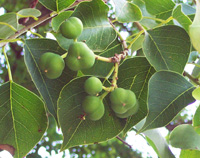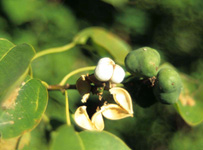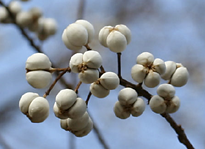
Tallow tree seed pods (immature)
|
The inventor, Stanley I. Mason Jr., recognized in 1978 that the Chinese tallow tree, which grows in abundance in U.S. Gulf Coast states, had great potential as a source of energy because of its vigorous growth pattern and the rich lipid content of its seeds. Together with H. William Scheld of Houston, Texas, Mason obtained a patent that described a system for exploiting the tree's potential, and he assigned the rights to Simco, Inc., a company he had earlier founded in his home town of Weston, Connecticut, to service his many other inventions.
In her biographical sketch of Mason, Judy Wearing writes about his tallow tree experiment in Hawaii and credits the project's ultimate failure as much to the Hawaiians' fear of the tree's invasiveness into Hawaii's delicate ecosystem as to the unconventional tree-cropping and novel mechanical harvester that Mason had designed. In the United States, the tallow tree's reproductive capacity and aggressive growth characteristics have also raised alarms about its invasiveness. Organizations such as the Nature Conservancy have conducted campaigns to eliminate tallow trees from areas where they threaten to displace older, more desirable domestic varieties of trees and shrubs. Clearly, invasiveness is an factor that must be addressed if tallow trees are cultivated on a large scale. In his treatise on the tallow tree, Paul A. Olivier opines that the state of Louisiana could become a leader in the production of green energy if only it would learn to appreciate a plant considered to be its enemy.
 Mature Tallow tree seed pod
(Woody husk has cracked open)
|
Before the tallow tree's potential as a major source of green energy can be fulfilled, other conditions would have to be met, not the least of which is the development of an efficient mechanical harvester. Already, a prototype of a research harvester has been developed by researchers (see video) at the University of California, Davis, in collaboration with an equipment manufacturer. They believe their harvester could be adapted for tallow tree use. Large commercial harvesters for picking berries could also be adapted for tallow tree use once there is sufficient financial incentive for modifying those machines.
There is also the major question of who will be the principal consumers of any large scale production of this energy source. Gary A. Breitenbeck and others have made the case for using the seeds of the tallow tree for the production of biodiesel, a convenient liquid fuel for which there is a present demand and widespread application in industry. However, the conversion does bear an energy cost as the seeds must be heated with alkali in the presence of methanol to convert their fatty acids into the methyl esters that comprise biodiesel. Separation, filtration and drying of the biodiesel also has an energy cost; although overall, those costs are moderate in comparison with the energy released through combustion in engines designed to operate with this fuel. Nevertheless, the production of biofuels from plant resources continues to gain in importance, and biodiesel in particular, for which the Jatropha plant has proved to be extremely well suited.
 Tallow tree seeds
(After woody husks have fallen)
|
An alternative use of tallow seeds is to employ it as feed stock in furnaces designed to generate steam to drive turbines that produce electricity. Enormous quantities of plant material would have to be readily available in order to consider this alternative, and cultivation would have to be conducted on a massive, industrialized scale involving hundreds of thousands of acres of trees. Nevertheless, it is realistic to consider that, as sources of readily available fossil fuel are gradually depleted over the next few hundred years, the shortfall will inevitably be made up by new vegetative sources of energy. In this scenario, the tallow tree's growth characteristics and rich energy content of its seeds rank it among the top choices for mass cultivation. Incidentally, bees convert pollen from the tallow tree into a honey having an "excellent flavor."
The following video is a simple backyard demonstration of the ability of Chinese tallow tree seeds to burn with vigor. A companion video (Part II) has additional details, while another video (Part III) is a primer on how tallow tree orchards could be planted and harvested.

